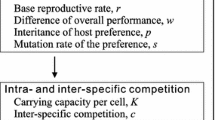Summary
Coexistence of defended and undefended plants may be maintained by herbivory. In the present paper this phenomenon is analyzed by means of evolutionary game theory. The plants in the model play either a defensive or a non-defensive strategy and they interact indirectly: when a plant is grazed its competitive ability decreases, because of this a neighboring plant makes a profit. The solution to the game leads to three qualitatively different cases depending on whether the profit is equal for the two strategies, defended and undefended, or if the profit is higher for one type than for the other. When the results are applied to intea-specific interactions, the model predicts that polymorphic populations should be expected only under certain specific conditions. When the results are applied to inter-specific interactions, the model predicts either stable coexistence, i.e., increased diversity, or a paradoxical situation without increased diversity.
Similar content being viewed by others
References
Belsky AJ (1986) Revegetation of artificial disturbances in grasslands of the Serengeti National Park, Tanzania. J Ecol 74:937–951
Bentley S, Whittaker JB (1979) Effects of grazing by a Chrysomelid beetle, Gastrophysa viridula, on competition between Rumex obtusifolia and Rumex crispus. J Ecol 67:79–90
Björkman C, Andersson DB (1990) Trade-offs among anti-herbivore defences in a South American blackberry (Rubus bogotensis). Oecologia 85:247–249
Brown BJ, Allen TFH (1989) The importance of scale in evaluating herbivory impacts. OIKOS 54:189–194
Burgess RSI, Ennos RA (1987) Selective grazing of acyanogenic white clover: variation in behaviour among populations of the slug Deroceras reticulatum. Oecologia 73:432–435
Coley PD (1986) Costs and benefits of defence by tannins in a neotropical tree. Oecologia 70:238–241
Crawley MJ (1983) Herbivory. The dynamics of animal-plant interactions. Blackwell, Oxford
Cresswell JE, Sayre CF (1991) Can evolutionarily stable strategies exist? OIKOS 60:382–385
Dirzo R, Harper JL (1982) Experimental studies on slug-plant interactions: IV. The performance of cyanogenic and acyanogenic morphs of Trifolium repens in the field. J Ecol 70:119–138
Edmunds GF, Alstad DN (1978) Coevolution in insect herbivores and conifers. Science 199:941–945
Fowler NL, Rausher MD (1985) Joint effects of competitors and herbivores on growth and reproduction in Aristolochia reticulata. Ecology 66(5):1580–1587
Harper JL (1977) Population biology of plants. Academic Press, London
Maynard Smith J (1982) Evolution and the theory of games. Cambridge University Press, Cambridge
McNaughton SJ (1979) Grazing as an optimization process: grassungulate relationships in the Serengeti. Am Nat 113:691–703
Rai JPN, Tripathi RS (1985) Effect of herbivory by the slug, Mariaelle dussumieri, and certain insects on growth and competitive success of two sympatric annual weeds. Agric Ecosyst Environ 13:125–137
Rosenthal GA, Janzen DH (1979) Herbivores. Their interaction with secondary plant metabolites. Academic Press, New York
White LM (1973) Carbohydrate reserves of grasses: a review. J Range Manage 26:13–18
Author information
Authors and Affiliations
Additional information
Offprint requests to: M. Augner
Rights and permissions
About this article
Cite this article
Augner, M., Fagerström, T. & Tuomi, J. Competition, defense and games between plants. Behav Ecol Sociobiol 29, 231–234 (1991). https://doi.org/10.1007/BF00163979
Received:
Accepted:
Issue Date:
DOI: https://doi.org/10.1007/BF00163979




